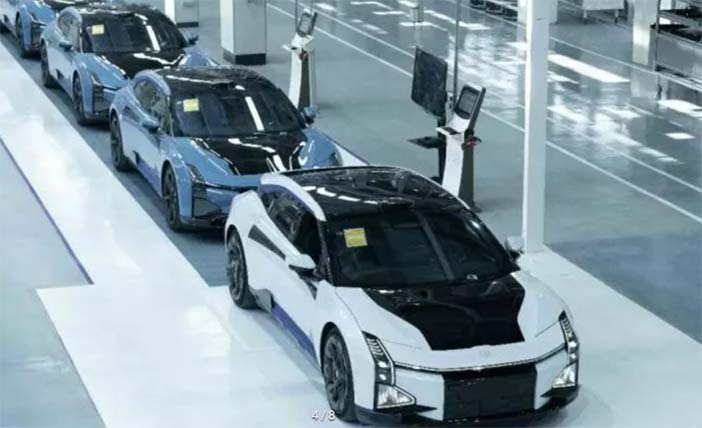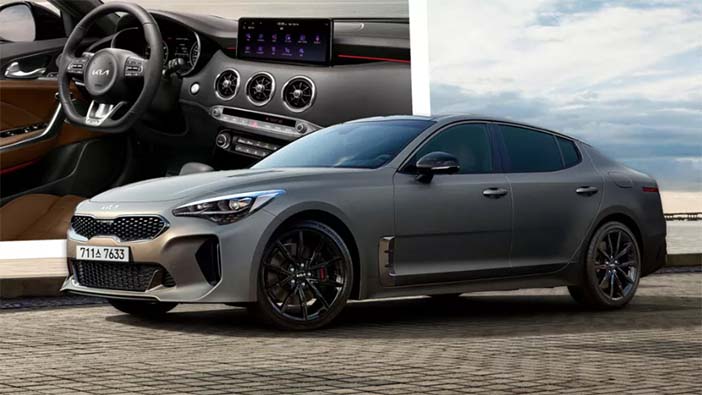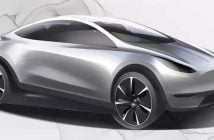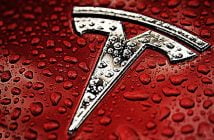+++ BMW is strengthening its partnership with Colorado’s Solid Power, a developer of advanced solid-state battery technologies. The partnership will see BMW pay Solid Power $20 million through June 2024 for the proprietary technology, including the company’s solid-state electrode design and manufacturing expertise. Solid Power will retain its intellectual property over the electrolyte material it has developed. “We look forward to working even more closely with Solid Power and adding the capability to produce solid-state cells based on Solid Power’s designs at our own pilot facility”, BMW management board member Frank Weber said. “We expect this agreement to accelerate the installation of our solid-state prototype line and our companies’ mutual goal of commercializing this promising cell technology”. Solid-state batteries are viewed by many as the next frontier in electric vehicles, promising to dramatically reduce costs, increase charging speeds and boost range. Solid-state batteries are also safer and said to be easier to produce. BMW has long been interested in the emerging technology. In fact, it first invested in Solid Power in 2017 alongside Ford. In June, Solid Power said it would begin to ship Silicon EV Cells to its automotive partners before the end of the year, allowing them to be tested. Solid Power anticipates manufacturing up to 15.000 large-format sulfide-based cells per year and will ultimately work with partners, including SK Innovation, to produce batteries at a scale large enough to supply automakers. BMW has previously promised to release a demonstrator vehicle using solid-state batteries well before 2025. +++
+++ A car described by some as a spaceship on wheels, the HIPHI Z , has just hit the production line in China and is one of the industry’s most striking cars. I haven’t heard much about the new model from Human Horizons since it was first showcased in production guise in early July. Over the last few months, the carmaker has charged forward with the development of the car and on December 20, the first examples rolled out of the factory. Much like the HiPhi X crossover that the Z follows in the footsteps of, its exterior design is very different than any other car. Beyond the intriguing shape of the Z, it also has a particularly interesting front fascia with a set of complex LED headlights and a rectangular grille finished in gloss black. The unique design choices of Human Horizons continue across the rear of the EV where there is a prominent LED light bar, a tiny rear window and a large diffuser. There is also a large spoiler stretching off from the roof. Found in the cabin of the HiPhi Z are a number of wild surfaces, including a dashboard housing complex LED ambient lighting and a massive central infotainment screen that can be positioned vertically or horizontally. A complex Head-Up Display is also standard, as is a 23-speaker Meridian audio system. Underpinning the car is a 120 kWh battery pack. This battery can be mated to either a single electric motor driving the rear wheels and pumping out 300 hp and 410 Nm of torque. Should customers wish, a dual-motor, all-wheeldrive model pumping out 600 hp and 820 Nm of torque is available. Human Horizons says this model can hit 100 km/h in 3.8 seconds. Adding to the appeal of the EV is the fact that it can travel up to 705 km on a single charge. Chinese customers can pick up the keys to the HiPhi Z for between 610,000 yuan and 630,000 yuan ($87,400 – $90,300). The first deliveries will start in January. +++

+++ The KIA STINGER is leaving production with a special limited run model. Dubbed the Tribute Edition, this version of the Stinger gets a unique paint color, special interior features and a numbered door sill plate on the driver’s side. Only 1.000 will be built for the entire world as the Stinger exits production in 2023. The Stinger is a special car for Kia. It set a new high bar for performance within the brand and now it’s figuratively handing the torch off to the Kia EV6 GT. Each one of the 1.000 Tribute Edition cars will come with a twin-turbocharged V6. “The Stinger Tribute Edition denotes an important chapter in the story of Kia’s high-performance ethos. Featuring an exclusive color and interior trim never before seen on the sedan, it also serves as a fitting celebration of the Stinger’s contribution to the Kia brand”, said Chang Sung Ryu, senior vice president and head of purchase CX Design Sub division. To clarify, Kia will allow customers to choose a new Moonscape matte gray paint for their Tribute Edition example. Each one gets 19 inch black wheels and Brembo brake calipers. The interior of each car will feature Terracotta brown leather along with carbon-effect finish on the upper cover of the console and door panels. Wasp-shaped emblems are embedded into the headrests. Sadly, the Stinger Tribute Edition isn’t getting any more power. While the world has speculated and rumors have swirled about the end of Stinger production, this seems to be the nail in the coffin. Kia specifically says that “the Tribute Edition pays homage… as production of the groundbreaking model comes to an end”. One thing Kia has not clarified is when exactly the final Stinger will roll off of the production line. I’m also not sure about exactly how many of the 1.000 units will come to the Netherlands (to be honest: I expect none). +++

+++ Mercedes is getting ready to roll out its first ever MAYBACH branded EV, which will take the form of an even more luxurious EQS SUV. Our first taste of the opulent off-roader came in 2021 when Mercedes showed a concept Maybach EQS at the Munich Motor Show, but we’ve since seen prototypes of the EQS flagship testing in summer weather, and this time we’ve spotted them in the snow wearing even less disguise. Not that this rather dowdy-looking test car is giving away many clues about its lofty status in the EQS range. When the real thing is launched next year as a 2024 model we can expect it look closer to the show car, with expensive two-tone paint, distinctive alloy wheels and a unique Maybach pinstripe grille and bumpers. But even those differences will only represent simple detail changes over the regular EQS SUV. The sheetmetal is identical between the cars, and even the electric motors could be shared with lesser models like the EQS 580. That would give Maybach 544 hp and 858 Nm of torque. Where the Maybach will really try to differentiate itself from its less expensive brothers is on the other side of those self-latching doors. Like the EQS 580, and unlike the cheaper EQS 450, the Maybach will get Merc’s triple-display Hyperscreen dashboard as standard, but will outdo both of those cars with even more opulent leather trim and a different cabin layout. The standard EQS SUV comes with a 5-seat configuration and the option to add a third row of seats in the trunk. But like the 2021 concept, the production Maybach EQS SUV is expected to offer 2 individual seats separated by a console in the second row and no third-row option. I can only speculate on how much this flagship EQS is going to cost, but based on the €176.245 Mercedes wants for an EQS 580 AMG Line (Dutch pricing), I won’t be surprised to see the Maybach top €210.000. That’s a big chunk of change, but right now there are almost no serious rivals in the uber-luxury electric SUV space, meaning Mercedes could clean up. +++
+++ After numerous delays and needing to sell $123 million worth of its car collection to fix technical issues for the Artura, MCLAREN has already issued the first recall for the hybrid supercar. A National Highway Traffic Safety Administration (NHTSA) recall notice has revealed that select McLaren Artura models were produced with cold formed nuts on the high-pressure fuel pipes. Vehicle loads can loosen the male threaded outlet connection of the direct injection fuel pump. If this nut becomes loose, fuel may leak onto surrounding engine components, potentially triggering a fire. McLaren states that the cold formed nut may have a lower residual torque rating than is necessary. The British car manufacturer had originally intended on using fully machined nuts on the Artura’s fuel pipes. However, in March 2021, the supplier said it was experiencing a shortage of machined nuts and proposed switching to cold form nuts. These had been validated by both the supplier and in durability testing by McLaren. Fast forward to June 2022, an Artura experienced a fuel leak on a racetrack and it was soon discovered that the cold formed nut of the left-hand high-pressure fuel pipe had loosened. McLaren thought it had fixed the issue by validating a new tightening procedure for the cold formed nuts but in November 2022, a different Artura experienced a fuel leak while being driven on a track by one of the carmaker’s race drivers. To fix the issue, McLaren will now install new high-pressure fuel pipes with 16.5 mm fully machined nuts with cut threads. A total of 164 examples are involved in the recall which were manufactured between October 8, 2021 and November 14, 2022. Most Artura models built after September 2022 are not involved because McLaren started using fully machined nuts in production in September. +++
+++ Porsche has been pumping out special models for many of its models recently and the PANAMERA could be next. My spy photographers were able to capture a test car during development with center-lock wheels, which could suggest a hotter variant is down the line. Porsche typically reserves center-lock wheels for their highest-performance vehicles such as their Turbo GT, GTS and Turbo S models, and seeing as the Panamera already offers the latter 2 models without center-locks, the new photos seem to suggest that this could be a new GT variant. These center-lock wheels have a unique design not found on any of the other prototypes, suggesting they could be exclusive for this model. Of course, there is the chance that the new Panamera might just have center-lock wheels on the GTS and/or Turbo S models, but a new rear diffuser similar to the one on the Cayenne Turbo GT seems to suggest that Porsche might be cooking up a Panamera Turbo GT as well. Additionally, the unfinished exhaust pipes at the corners of the bumper insinuate that might not be their final location, and instead we might see them shift to dual center pipes in the diffuser just like that aforementioned Cayenne Turbo GT. Up front, there’s a new bumper design with larger, squared-off openings, and while it does somewhat resemble that of the Cayenne Turbo GT, all the other Panamera prototypes we’ve seen so far have had that same or similar fascia, and they would theoretically be lower-trim models. In all likelihood, this is probably just what the front-end design of the new Panamera will look like. That being said, this car is the only prototype we’ve seen so far with red brake calipers, which helps further the notion that this might be something special. If the car truly is a Turbo GT, we could potentially expect an uprated version of the Panamera Turbo S’s 4.0L twin-turbo V8, as that was what Porsche did to the Cayenne Turbo GT. In that case, the car would make 640 hp and 850 Nm of torque. Should this be something other than a Turbo GT, though, it’s likely that its engine will remain similar to what’s currently offered in that respective model, as this new Panamera is expected to be more of a revision than an all-new car. +++
+++ PORSCHE has started the production of synthetic fuels alongside its international partners in Punta Arenas, Chile. The facility was opened in the presence of Chilean energy minister Diego Pardow and Porsche Executive Board members Barbara Frenkel and Michael Steiner performed a ceremonial fueling of a Porsche 911 with the first batch of synthetic fuel produced at the site. The pilot phase of eFuel production will see approximately 130.000 liters produced each year. This fuel will initially be used in projects such as the Porsche Mobil 1 Supercup, as well as at Porsche Experience Centers. After the pilot phase has run its course, the project will expand and is expected to produce 55 million liters per year by the middle of the decade. The site will ultimately be able to produce 550 million liters of eFuel per year. “Porsche is committed to a double-e path: e-mobility and eFuels as a complementary technology”, member of the Executive Board for Procurement at Porsche, Barbara Frenkel said. “Using eFuels reduces CO2 emissions. Looking at the entire traffic sector, the industrial production of synthetic fuels should keep being pushed forward worldwide. With the eFuels pilot plant, Porsche is playing a leading role in this development”. The south of Chile was chosen because the wind blows for roughly 270 days a year, enabling the wind turbines to operate at full capacity. Additionally, Punta Arenas is near the Straight of Magellan, meaning eFuel can easily be transported and distributed using existing infrastructure. The German car manufacturer wants to go CO2 neutral across its entire value chain by 2030 and has already invested over $100 million in the development and production of eFuels. It is also planning eFuel plants in the U.S. and Australia. “The potential of eFuels is huge”, added member of the Executive Board for Development and Research at Porsche, Michael Steiner. “There are currently more than 1.3 billion vehicles with combustion engines worldwide. Many of these will be on the roads for decades to come, and eFuels offer the owners of existing cars a nearly carbon-neutral alternative. As the manufacturer of high-performance, efficient engines, Porsche has a wide range of know-how in the field of fuels”. +++
+++ TESLA is preparing a wave of layoffs in the first quarter of 2023 and plans to implement a hiring freeze. A source familiar with the matter tells that the hiring freeze has already been implemented, although it is not yet clear how extensive the freeze will be nor how long it will be in effect. Tesla has not commented on the report. The hiring freeze and job cuts come approximately 6 months after chief executive Elon Musk announced that executives had been told to “pause all hiring” and that the car manufacturer would cut 10 percent of all staff. This hiring pause didn’t last long and Tesla’s workforce began to grow again through the second half of the year. The move comes at a tumultuous time for Tesla in the stock market. The company’s stock spent the first 9 months of this year largely tracking the Nasdaq as a whole but ever since Elon Musk’s acquisition of Twitter in October, has been in free fall. Recently-announced discounts for Tesla models also indicates that the company is facing some demand problems. Tesla’s hiring freeze comes despite its planning to continue to build up production at factories around the world. Not only is it expected to break ground on a brand new factory in Mexico next year but it is also looking to double the capacity of its factory in Germany. Indeed, it wants to increase capacity from 500.000 units a year to 1 million units, something that will obviously require a significant increase in staff. +++



